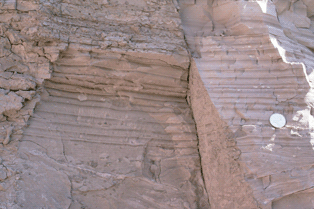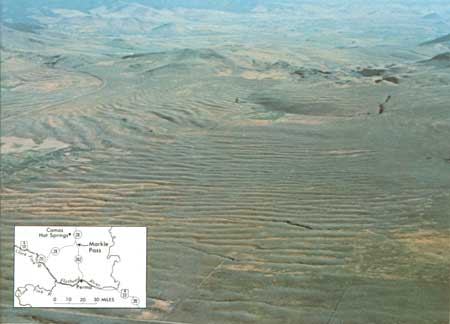|
Rhythmite
A rhythmite consists of layers of sediment or sedimentary rock which are laid down with an obvious periodicity and regularity. They may be created by annual processes such as seasonally varying deposits reflecting variations in the runoff cycle, by shorter term processes such as tides, or by longer term processes such as periodic floods. Rhythmites serve a significant role in unraveling prehistoric events, providing insights into sea level change, glaciation change, and earth's orbital variations which serve to answer questions about climate change. Annually-laminated rhythmites Annually-laminated deposits (varves) are rhythmites with annual periodicity: annual layers of sediment or sedimentary rock are laid down through seasonal variations that result from precipitation, or from temperature, which influences precipitation rates and debris loads in runoff. Of the many rhythmites found in the geological record, varves are among the most important and illuminating to studies of pa ... [...More Info...] [...Related Items...] OR: [Wikipedia] [Google] [Baidu] |
Touchet Formation
The Touchet Formation or Touchet beds consist of large quantities of gravel and fine sediment which overlay almost a thousand meters (several thousand feet) of volcanic basalt of the Columbia River Basalt Group in south-central Washington and north-central Oregon. The beds consist of between 6 and 40 distinct rhythmites – horizontal layers of sediment, each clearly demarcated from the layer below. These Touchet beds are often covered by windblown loess soils which were deposited later; the number of layers varies with location. The beds vary in depth from at lower elevations where a number of layers can be found to a few extremely thin layers at the maximum elevation where they are observed (). The Touchet beds are one element in a chain of evidence which helped identify and define the progression of the Missoula Floods, which occurred around 16,450 to 13,750 years BCE. During the floods, flow through the Wallula Gap was slow enough such that water pooled in a temporary ... [...More Info...] [...Related Items...] OR: [Wikipedia] [Google] [Baidu] |
Varve
A varve is an annual layer of sediment or sedimentary rock. The word 'varve' derives from the Swedish word ''varv'' whose meanings and connotations include 'revolution', 'in layers', and 'circle'. The term first appeared as ''Hvarfig lera'' (varved clay) on the first map produced by the Geological Survey of Sweden in 1862. Initially, "varve" referred to each of the separate components comprising a single annual layer in glacial lake sediments, but at the 1910 Geological Congress, the Swedish geologist Gerard De Geer (1858–1943) proposed a new formal definition, where varve means the whole of any annual sedimentary layer. More recently introduced terms such as 'annually laminated' are synonymous with varve. Of the many rhythmites in the geological record, varves are one of the most important and illuminating in studies of past climate change. Varves are amongst the smallest-scale events recognised in stratigraphy. An annual layer can be highly visible because the particles wash ... [...More Info...] [...Related Items...] OR: [Wikipedia] [Google] [Baidu] |
Missoula Floods
The Missoula floods (also known as the Spokane floods or the Bretz floods or Bretz's floods) were cataclysmic glacial lake outburst floods that swept periodically across eastern Washington and down the Columbia River Gorge at the end of the last ice age. These floods were the result of periodic sudden ruptures of the ice dam on the Clark Fork River that created Glacial Lake Missoula. After each ice dam rupture, the waters of the lake would rush down the Clark Fork and the Columbia River, flooding much of eastern Washington and the Willamette Valley in western Oregon. After the lake drained, the ice would reform, creating Glacial Lake Missoula again. These floods have been researched since the 1920s. During the last deglaciation that followed the end of the Last Glacial Maximum, geologists estimate that a cycle of flooding and reformation of the lake lasted an average of 55 years and that the floods occurred several times over the 2,000-year period between 15,000 and 13,000 year ... [...More Info...] [...Related Items...] OR: [Wikipedia] [Google] [Baidu] |
Mont Saint-Michel
Mont-Saint-Michel (; Norman: ''Mont Saint Miché''; ) is a tidal island and mainland commune in Normandy, France. The island lies approximately off the country's north-western coast, at the mouth of the Couesnon River near Avranches and is in area. The mainland part of the commune is in area so that the total surface of the commune is . , the island had a population of 29.Téléchargement du fichier d'ensemble des populations légales en 2019 INSEE The commune's position—on an island just a few hundred metres from land—made it accessible at low tide to the many ... [...More Info...] [...Related Items...] OR: [Wikipedia] [Google] [Baidu] |
Incremental Dating
Incremental dating techniques allow the construction of year-by-year annual chronologies, which can be temporally fixed (''i.e.,'' linked to the present day and thus calendar or sidereal time) or floating. Archaeologists use tree-ring dating ( dendrochronology) to determine the age of old pieces of wood. Trees usually add growth rings on a yearly basis, with the spacing of rings being wider in high growth years and narrower in low growth years. Patterns in tree-ring growth can be used to establish the age of old wood samples, and also give some hints to local climatic conditions. This technique is useful to about 9,000 years ago for samples from the western United States using overlapping tree-ring series from living and dead wood. The Earth's orbital motions (inclination of the earth's axis on its orbit with respect to the sun, gyroscopic precession of the earth's axis every 26,000 years; free precession every 440 days, precession of earth orbit and orbital variations such as ... [...More Info...] [...Related Items...] OR: [Wikipedia] [Google] [Baidu] |
Dendroclimatology
Dendroclimatology is the science of determining past climates from trees (primarily properties of the annual tree rings). Tree rings are wider when conditions favor growth, narrower when times are difficult. Other properties of the annual rings, such as maximum latewood density (MXD) have been shown to be better proxies than simple ring width. Using tree rings, scientists have estimated many local climates for hundreds to thousands of years previous. By combining multiple tree-ring studies (sometimes with other climate proxy records), scientists have estimated past regional and global climates. Advantages Tree rings are especially useful as climate proxies in that they can be well-dated via dendrochronology, i.e. matching of the rings from sample to sample. This allows extension backwards in time using deceased tree samples, even using samples from buildings or from archeological digs. Another advantage of tree rings is that they are clearly demarked in annual increments, as op ... [...More Info...] [...Related Items...] OR: [Wikipedia] [Google] [Baidu] |
Dendrochronology
Dendrochronology (or tree-ring dating) is the scientific method of dating tree rings (also called growth rings) to the exact year they were formed. As well as dating them, this can give data for dendroclimatology, the study of climate and atmospheric conditions during different periods in history from wood. Dendrochronology derives from Ancient Greek (), meaning "tree", (), meaning "time", and (), "the study of". Dendrochronology is useful for determining the precise age of samples, especially those that are too recent for radiocarbon dating, which always produces a range rather than an exact date. However, for a precise date of the death of the tree a full sample to the edge is needed, which most trimmed timber will not provide. It also gives data on the timing of events and rates of change in the environment (most prominently climate) and also in wood found in archaeology or works of art and architecture, such as old panel paintings. It is also used as a check in radiocar ... [...More Info...] [...Related Items...] OR: [Wikipedia] [Google] [Baidu] |
Permian Period
The Permian ( ) is a geologic period and stratigraphic system which spans 47 million years from the end of the Carboniferous Period million years ago (Mya), to the beginning of the Triassic Period 251.9 Mya. It is the last period of the Paleozoic Era; the following Triassic Period belongs to the Mesozoic Era. The concept of the Permian was introduced in 1841 by geologist Sir Roderick Murchison, who named it after the region of Perm in Russia. The Permian witnessed the diversification of the two groups of amniotes, the synapsids and the sauropsids (reptiles). The world at the time was dominated by the supercontinent Pangaea, which had formed due to the collision of Euramerica and Gondwana during the Carboniferous. Pangaea was surrounded by the superocean Panthalassa. The Carboniferous rainforest collapse left behind vast regions of desert within the continental interior. Amniotes, which could better cope with these drier conditions, rose to dominance in place of their amphibia ... [...More Info...] [...Related Items...] OR: [Wikipedia] [Google] [Baidu] |
Pennsylvanian Period
The Pennsylvanian ( , also known as Upper Carboniferous or Late Carboniferous) is, in the International Commission on Stratigraphy, ICS geologic timescale, the younger of two period (geology), subperiods (or upper of two system (stratigraphy), subsystems) of the Carboniferous Period. It lasted from roughly . As with most other geochronology, geochronologic units, the stratum, rock beds that define the Pennsylvanian are well identified, but the exact date of the start and end are uncertain by a few hundred thousand years. The Pennsylvanian is named after the U.S. state of Pennsylvania, where the coal-productive beds of this age are widespread. The division between Pennsylvanian and Mississippian (geology), Mississippian comes from North American stratigraphy. In North America, where the early Carboniferous beds are primarily marine limestones, the Pennsylvanian was in the past treated as a full-fledged geologic period between the Mississippian and the Permian. In parts of Europe, ... [...More Info...] [...Related Items...] OR: [Wikipedia] [Google] [Baidu] |
Big Cottonwood Canyon
Big Cottonwood Canyon is a canyon in the Wasatch Range southeast of Salt Lake City in the U.S. state of Utah. The -long canyon provides hiking, biking, picnicking, rock-climbing, camping, and fishing in the summer. Its two ski resorts, Brighton and Solitude, are popular among skiers and snowboarders. The canyon is accessed by The Big Cottonwood Canyon Scenic Byway (SR-190), which runs its length to Guardsman Pass at the top of the canyon, allowing travel to Park City in the summer months. Guardsman Pass is closed during the winter months and is a popular snowshoe hiking destination for many Utahns. Hiking to the canyon's mountain lakes is popular, with many trails leading to lakes such as Mary, Martha, and Katherine. The canyon's most popular hiking trail leads to Lakes Blanche, Florence and Lillian. The trail is long and a strenuous hike. Since the canyon was formed by Big Cottonwood Creek, the V-shaped canyon has many impressive rock forms. The canyon is also a frequ ... [...More Info...] [...Related Items...] OR: [Wikipedia] [Google] [Baidu] |
Bay Of Fundy
The Bay of Fundy (french: Baie de Fundy) is a bay between the Canadian provinces of New Brunswick and Nova Scotia, with a small portion touching the U.S. state of Maine. It is an arm of the Gulf of Maine. Its extremely high tidal range is the highest in the world. The name is likely a corruption of the French word , meaning 'split'. Hydrology Tides The tidal range in the Bay of Fundy is about ; the average tidal range worldwide is only . Some tides are higher than others, depending on the position of the moon, the sun, and atmospheric conditions. Tides are semidiurnal, meaning they have two highs and two lows each day, with about six hours and 13 minutes between each high and low tide. Because of tidal resonance in the funnel-shaped bay, the tides that flow through the channel are very powerful. In one 12-hour tidal cycle, about 100 billion tons (110 billion short tons) of water flows in and out of the bay, which is twice as much as the combined total flow of all the rive ... [...More Info...] [...Related Items...] OR: [Wikipedia] [Google] [Baidu] |






